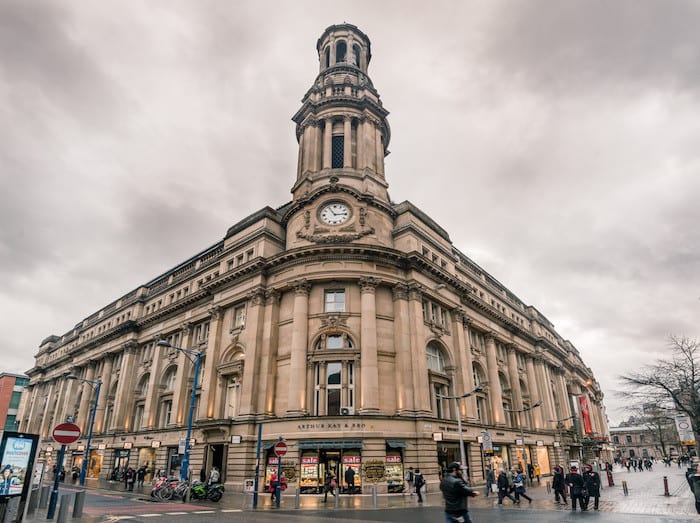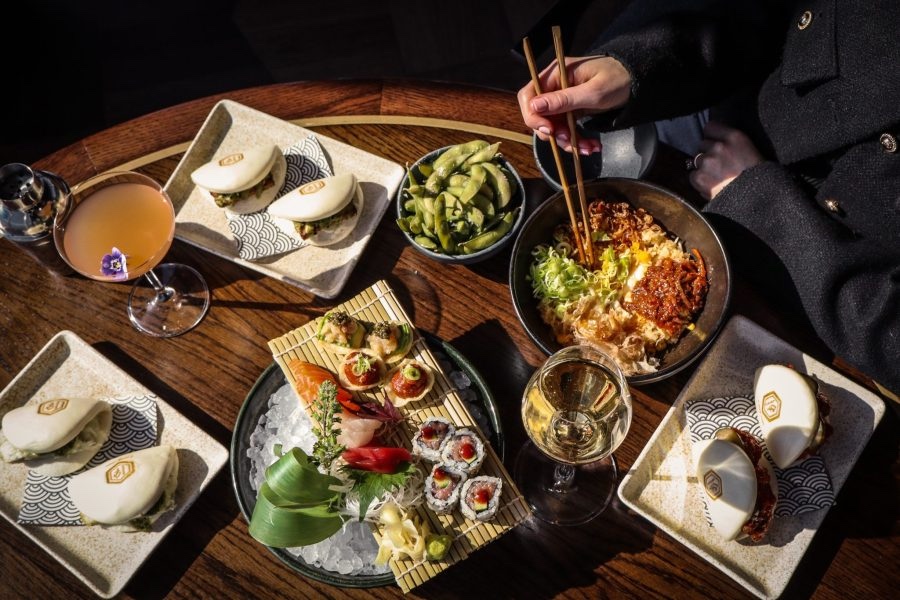From cotton trading to thriving retail hub: The Royal Exchange Manchester is still a hive of activity
- Written by Ray King
- Last updated 7 years ago
- City of Manchester, History, Shopping, Sponsored, Videos

Fifty years ago this year, one of Manchester’s biggest, most historic and iconic buildings was threatened with demolition.
Dominating the cityscape between St Ann’s Square, Cross Street and St Mary’s Gate at the very heart of the city, The Royal Exchange had been the epicentre of ‘Cottonopolis’ and the largest trading room in the world.
But in 1968, business on the massive trading floor ceased. The cotton barons who ran mills employing tens of thousands in the towns around Manchester, went away for good. And their great business meeting place stood empty for the next five years.
The original trading board with the day’s closing figures from 1968 is still on display in the Great Hall. But time hasn’t stood still. Today, half a century after the trading stopped, the Royal Exchange is trading and thriving in a very different dimension.
It has become a magnet for high-end shoppers and a must for most-wanted St Valentine’s Day gifts. Retail businesses on all sides of the classical style, Portland stone building – and the splendid arcade that cuts through it – include premium brand fashion stores, jewellery and gift shops, beauty specialists, bridal and designer outlets.
New, very sophisticated, kids on the block include Watches of Switzerland, a branch of Swarovski, the world famous jewellery brand, a new flagship store for the fashion, clothing and accessories retailer French Connection, the Whisky Shop which offers the best of Scotland’s single malts and more, and luxury bath and beauty specialists Molton and Brown.
They have joined established ventures like Moss Bros and Arthur Kay’s Jewellers, now celebrating 125 years in business.
But the Royal Exchange had to survive several near-fatal episodes to get where it is today.














The city’s first exchange opened in 1729, but closed before the end of the century. As the cotton industry boomed, however, Thomas Harrison designed a new one occupying much of the present site, which was opened to celebrate King George III’s birthday in 1809.
That building too was replaced by Mills and Murgatroyd’s third exchange, constructed between 1867 and 1874 and extended over time between 1914 and 1931 to house the largest trading hall in England under three soaring domes.
But it suffered major damage from a direct hit by a German bomb during the Manchester Blitz of Christmas 1940 and was rebuilt with a smaller trading area.
Threatened with demolition during its five years of closure, the magnificent building was rescued by one of the most audacious changes of use ever contemplated.
https://ilovemanchester.com/2016/11/21/revealed-the-horrible-history-of-the-royal-exchange.aspx
A futuristic, 150-tonne theatre-in-the-round resembling a giant space ship was constructed in the middle of the old trading floor, and the newly created Royal Exchange Theatre company was formally opened by the UK’s leading actor, Sir Laurence Olivier, in September 1976.
Over the past 40 years, the 360 degree performance space (the largest theatre-in-the-round in the country) has welcomed some of the greatest names in British theatre, film and television, including Helen Mirren, Kate Winslet and Maxine Peake. Though the main theatre seats up to 750 people on three levels, no seat is further than nine metres away from the stage which gives a uniquely intimate audience experience.
But more than half a decade after the Blitz damage, more trouble was to come for the Grade II listed building.
The IRA terror attack of June 1996 saw the biggest bomb ever detonated on the UK mainland in peacetime explode 50 yards away from the Royal Exchange. At first the building appeared relatively undamaged, but repairs were to take two years and cost £32 million. The theatre was back up and running two years later, having temporarily relocated to Castlefield.
Despite a history of potentially catastrophic setbacks, the Royal Exchange has survived and indeed thrived over the years thanks to the resilience, adaptability and innovation of the building and its inhabitants – a true tribute to an ever-evolving city.
- This article was last updated 7 years ago.
- It was first published on 24 January 2018 and is subject to be updated from time to time. Please refresh or return to see the latest version.
Did we miss something? Let us know: press@ilovemanchester.com
Want to be the first to receive all the latest news stories, what’s on and events from the heart of Manchester? Sign up here.
Manchester is a successful city, but many people suffer. I Love Manchester helps raise awareness and funds to help improve the lives and prospects of people across Greater Manchester – and we can’t do it without your help. So please support us with what you can so we can continue to spread the love. Thank you in advance!
An email you’ll love. Subscribe to our newsletter to get the latest news stories delivered direct to your inbox.
Got a story worth sharing?
What’s the story? We are all ears when it comes to positive news and inspiring stories. You can send story ideas to press@ilovemanchester.com
While we can’t guarantee to publish everything, we will always consider any enquiry or idea that promotes:
- Independent new openings
- Human interest
- Not-for-profit organisations
- Community Interest Companies (CiCs) and projects
- Charities and charitable initiatives
- Affordability and offers saving people over 20%
For anything else, don’t hesitate to get in touch with us about advertorials (from £350+VAT) and advertising opportunities: advertise@ilovemanchester.com



The eclectic group that’s been helping writers cut their teeth for 50 years

“His presence will be deeply missed” Children’s hospice bids farewell to their visionary CEO

Has Gordon Ramsay created Manchester’s ultimate bottomless brunch?















